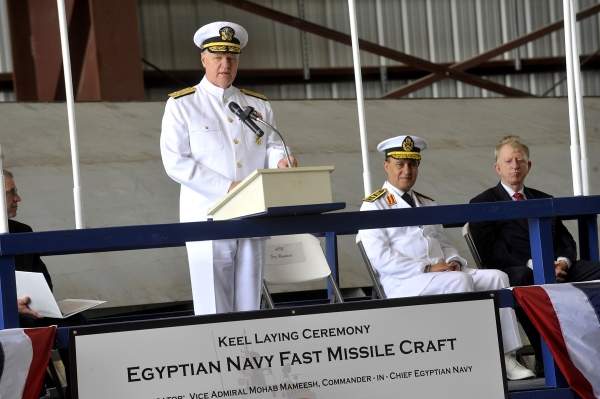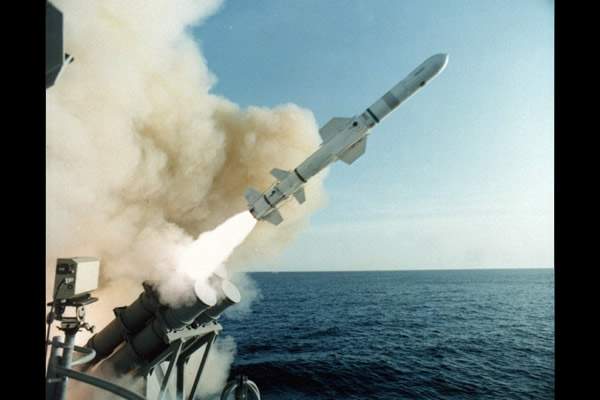The Egyptian Navy’s fast missile craft (FMC), also called the Ambassador IV-Class patrol craft, is a missile boat developed by VT Halter Marine, a subsidiary of ST Engineering. The FMC can accommodate a crew of up to 40 sailors. It has been developed in the US for the Egyptian Navy under the foreign military sales (FMS) programme.
The Egyptian Government has been replacing its ageing fast attack craft (FACs), which have been in service since 1966 and since the 1990s. The navy has procured four fast missile boats from the US Navy.
The new FMC vessels will be used to defend armed surface and shipping threats in the coastal waterways of the Mediterranean Sea, Suez Canal and Red Sea. The FMC will perform coastal patrolling both independently and jointly for surveillance, surface strike operations, interdiction and task group support missions.
PEO Ships, the US Navy’s Program Executive Office (PEO), is responsible for the Egyptian deal. The total value of the Egyptian FMC programme is expected to be about $1.3bn.
Construction of the first FMC began in December 2009. Keel for the vessel was laid at the VT Halter Marine shipyard in Pascagoula, Mississippi, in April 2010. It was launched in October 2011.
The first of the four FMCs, S Ezzat, was named in the honour of Commander in Chief Admiral Soliman Ezzat, who served the Egyptian Navy between 1953 and 1967. S Ezzat was delivered to the Navy in November 2013 and the remaining three FMCs, F. Zekry, M. Fahmy and A Gad, are expected to be delivered by the end of 2014. VT Halter Marine received $807m in total towards construction of the four missile craft.
Fast missile craft (FMC) design and features
VT Halter Marine originally designed the patrol boat in December 2005 under a $29m contract from the US Navy. It was designed in collaboration with Lockheed Martin.
The FMC patrol craft has been designed by VT Halter Marine. The company acts as the principal subcontractor and is responsible for system integration.
The 779ft, 63m-long FMC has high speed and manoeuvrability. Its beam is 10m and draft is 2m. Aluminium is used for superstructure to reduce the overall weight, maintenance and radar signature. Its hull is made of steel.
The FMC is designed to resist radar detection. It incorporates ship signature control technology. The ship is equipped with several sensors and combat systems for electronic, anti-aircraft and anti-surface warfare capabilities.
Ambassador IV-Class craft weapons / missiles / guns
The Egyptian Ambassador IV craft is armed with eight RGM-84L Boeing Harpoon surface-to-surface missiles, (SSM) Block II missiles, one Oto Melara MK75 76mm/62 Super Rapid DP gun, one MK31 Raytheon Rolling Airframe Missile (RAM) system with MK49 guided missile launching system (GMLS).
The vessel also contains a MK44 MOD 2 Block 1 guided missile round pack that can support 21 canister-mounted missiles, one Raytheon MK15 Mod 21 Phalanx Block 1B 20mm close-in weapon system (CIWS) and two deck-mounted 7.62mm M60 machine guns.
Propulsion / performance
The vessel is powered by three Tognum MTU diesel engines supplied by Detroit Diesel, three generators, three propellers and three shafts.
The propulsion system generates a total power of 30,000shp (22,380kW) providing a maximum speed of 41kt. The vessel has a range of 2,000nm at 15kt. The mission endurance of the FMC is eight days at sea.
Communications / radar / combat management systems
The FMC vessel is equipped with Thales Naval Nederland Scout (I/J band) radar, MRR-3D ES radar for surface and air surveillance and I and K dual-band fire control radar from DRS Radar Systems.
It is also fitted with a Thales Naval Nederlands Link ASN 150, LinkYE, Link 14, and Link 11 datalinks, identification, friend or foe (IFF) identification systems, Lockheed Martin’s lightweight shipboard electro-optical combat management system and the L-3 Communications Brashear fire control system.
DRS Radar Systems provided its Scout navigation radar, 3D long-range multirole radar for air / surface search, in addition to the Thales Tacticos combat management system and Sting optronic director. L-3 Communications provided the integrated communications system (ICS).
The countermeasures of the vessel include Argon ST WBR-2000 electronics support measures / electronic countermeasures (ESM/ECM) suite and four MK32 chaf f/ IR launchers from BAE Systems land and armament systems division.
The Global Naval Surface Combatants and Warfare Systems Market 2011-2021
This project forms part of our recent analysis and forecasts of the global naval surface combatants and warfare systems market available from our business information platform Strategic Defence Intelligence. For more information click here or contact us: EMEA: +44 20 7936 6783; Americas: +1 415 439 4914; Asia Pacific: +61 2 9947 9709 or via email.






